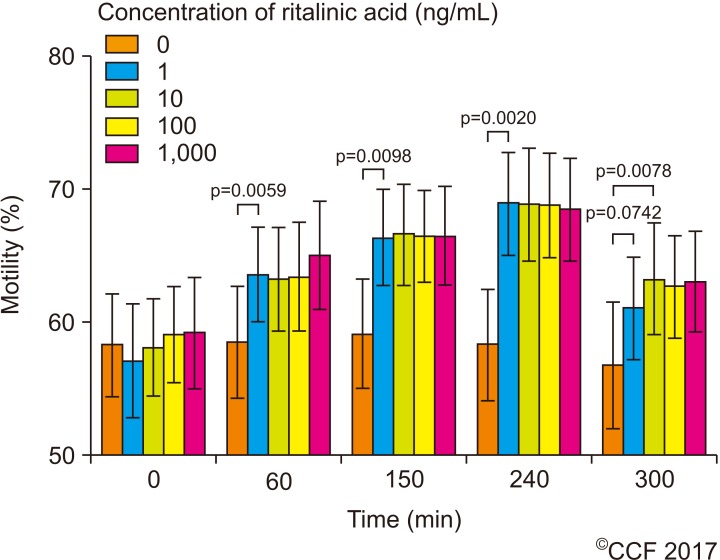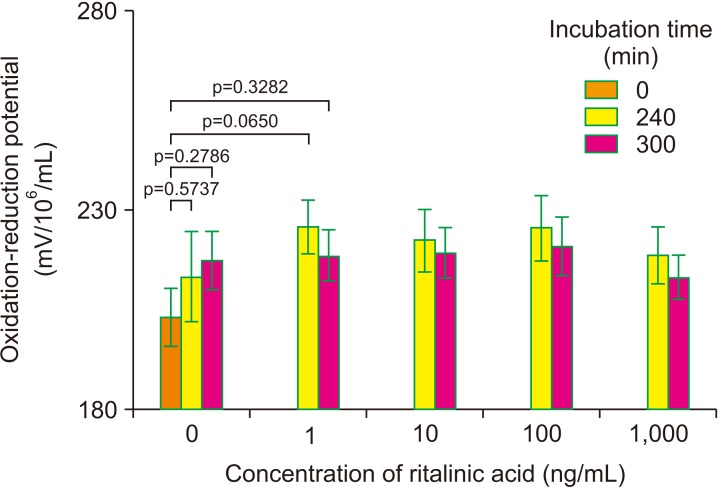World J Mens Health.
2020 Jan;38(1):61-67. 10.5534/wjmh.180127.
Ritalinic Acid Stimulates Human Sperm Motility and Maintains Vitality In Vitro
- Affiliations
-
- 1Fertility and IVF Unit, Soroka University Medical Center, Ben-Gurion University of the Negev, Beer Sheva, Israel. harlev@bgu.ac.il
- 2American Center for Reproductive Medicine, Cleveland Clinic, Cleveland, OH, USA.
- 3Department of Medical Bioscience, University of the Western Cape, Bellville, South Africa.
- 4Department of Zoology, School of Life Sciences, Ravenshaw University, Orissa, India.
- KMID: 2465410
- DOI: http://doi.org/10.5534/wjmh.180127
Abstract
- PURPOSE
To evaluate the in vitro impact of ritalinic acid (RA), a major metabolite of methylphenidate (drug to treat attention-deficit hyperactivity disorder), on sperm motility, vitality and oxidative stress.
MATERIALS AND METHODS
Semen samples (n=13) were collected from healthy donors and a semen analysis was performed according to World Health Organization. Density gradient centrifugation was performed to isolate motile sperm. Samples were incubated with different concentrations (0, 1, 10, 100, and 1,000 ng/mL) of RA. The non-exposed group (0 ng/mL) was defined as the control group. Samples were analyzed for motility at different time points (0, 60, 150, 240, and 300 minutes) and for vitality and oxidation reduction potential (ORP) (at 0, 240, and 300 minutes). Sperm motility was assessed manually and motion kinetic parameters were recorded by computer aided semen analysis.
RESULTS
RA at any tested concentration significantly increased sperm motility compared to the control in a time-dependent manner with a maximum increase after 240 minutes. Motion kinetic parameters were not comparable. For sperm vitality, supplementation with RA significantly maintained survival at higher levels, while non-treated sperm gradually died. These higher levels of vitality were maintained with rising RA concentrations of up to 1,000 ng/mL. A non-significant trend of increased ORP was observed in all study groups.
CONCLUSIONS
RA increases sperm motility and maintains vitality at any concentration tested. Therefore, RA might be utilized to improve sperm quality in asthenozoospermic specimens. However, further investigation is ongoing to evaluate the effect of RA on other sperm parameters.
Keyword
MeSH Terms
Figure
Reference
-
1. Chai G, Governale L, McMahon AW, Trinidad JP, Staffa J, Murphy D. Trends of outpatient prescription drug utilization in US children, 2002–2010. Pediatrics. 2012; 130:23–31. PMID: 22711728.
Article2. Renoux C, Shin JY, Dell'Aniello S, Fergusson E, Suissa S. Prescribing trends of attention-deficit hyperactivity disorder (ADHD) medications in UK primary care, 1995–2015. Br J Clin Pharmacol. 2016; 82:858–868. PMID: 27145886.
Article3. Moffitt TE, Houts R, Asherson P, Belsky DW, Corcoran DL, Hammerle M, et al. Is adult ADHD a childhood-onset neurodevelopmental disorder? Evidence from a four-decade longitudinal cohort study. Am J Psychiatry. 2015; 172:967–977. PMID: 25998281.
Article4. Jenson D, Yang K, Acevedo-Rodriguez A, Levine A, Broussard JI, Tang J, et al. Dopamine and norepinephrine receptors participate in methylphenidate enhancement of in vivo hippocampal synaptic plasticity. Neuropharmacology. 2015; 90:23–32. PMID: 25445492.5. Kodama T, Kojima T, Honda Y, Hosokawa T, Tsutsui KI, Watanabe M. Oral administration of methylphenidate (ritalin) affects dopamine release differentially between the prefrontal cortex and striatum: a microdialysis study in the monkey. J Neurosci. 2017; 37:2387–2394. PMID: 28154152.
Article6. Volkow ND, Wang GJ, Smith L, Fowler JS, Telang F, Logan J, et al. Recovery of dopamine transporters with methamphetamine detoxification is not linked to changes in dopamine release. Neuroimage. 2015; 121:20–28. PMID: 26208874.
Article7. Modi NB, Wang B, Noveck RJ, Gupta SK. Dose-proportional and stereospecific pharmacokinetics of methylphenidate delivered using an osmotic, controlled-release oral delivery system. J Clin Pharmacol. 2000; 40:1141–1149. PMID: 11028253.8. Wargin W, Patrick K, Kilts C, Gualtieri CT, Ellington K, Mueller RA, et al. Pharmacokinetics of methylphenidate in man, rat and monkey. J Pharmacol Exp Ther. 1983; 226:382–386. PMID: 6410043.9. Adjei A, Teuscher NS, Kupper RJ, Chang WW, Greenhill L, Newcorn JH, et al. Single-dose pharmacokinetics of methylphenidate extended-release multiple layer beads administered as intact capsule or sprinkles versus methylphenidate immediate-release tablets (Ritalin(®)) in healthy adult volunteers. J Child Adolesc Psychopharmacol. 2014; 24:570–578. PMID: 25514542.
Article10. Beckman DA, Schneider M, Youreneff M, Tse FL. Juvenile toxicity assessment of d,l-methylphenidate in rats. Birth Defects Res B Dev Reprod Toxicol. 2008; 83:48–67. PMID: 18189274.
Article11. Fazelipour S, Jahromy MH, Tootian Z, Kiaei SB, Sheibani MT, Talaee N. The effect of chronic administration of methylphenidate on morphometric parameters of testes and fertility in male mice. J Reprod Infertil. 2012; 13:232–236. PMID: 23926551.12. Nudmamud-Thanoi S, Thanoi S. Methamphetamine induces abnormal sperm morphology, low sperm concentration and apoptosis in the testis of male rats. Andrologia. 2011; 43:278–282. PMID: 21486410.
Article13. Cansu A, Ekinci O, Ekinci O, Serdaroglu A, Erdogan D, Coskun ZK, et al. Methylphenidate has dose-dependent negative effects on rat spermatogenesis: decreased round spermatids and testicular weight and increased p53 expression and apoptosis. Hum Exp Toxicol. 2011; 30:1592–1600. PMID: 21183565.
Article14. World Health Organization. WHO laboratory manual for the examination and processing of human semen. 5th ed. Geneva: World Health Organization;2010.15. Claassens OE, Wehr JB, Harrison KL. Optimizing sensitivity of the human sperm motility assay for embryo toxicity testing. Hum Reprod. 2000; 15:1586–1591. PMID: 10875871.
Article16. Cairns R, Daniels B, Wood DA, Brett J. ADHD medication overdose and misuse: the NSW Poisons Information Centre experience, 2004–2014. Med J Aust. 2016; 204:154. PMID: 26937669.
Article17. Gronier B. In vivo electrophysiological effects of methylphenidate in the prefrontal cortex: involvement of dopamine D1 and alpha 2 adrenergic receptors. Eur Neuropsychopharmacol. 2011; 21:192–204. PMID: 21146374.
Article18. Fait G, Vered Y, Yogev L, Gamzu R, Lessing JB, Paz G, et al. High levels of catecholamines in human semen: a preliminary study. Andrologia. 2001; 33:347–350. PMID: 11736795.
Article19. Urra JA, Villaroel-Espíndola F, Covarrubias AA, Rodríguez-Gil JE, Ramírez-Reveco A, Concha II. Presence and function of dopamine transporter (DAT) in stallion sperm: dopamine modulates sperm motility and acrosomal integrity. PLoS One. 2014; 9:e112834. PMID: 25402186.
Article20. Ramírez AR, Castro MA, Angulo C, Ramió L, Rivera MM, Torres M, et al. The presence and function of dopamine type 2 receptors in boar sperm: a possible role for dopamine in viability, capacitation, and modulation of sperm motility. Biol Reprod. 2009; 80:753–761. PMID: 19074002.21. Bavister BD, Chen AF, Fu PC. Catecholamine requirement for hamster sperm motility in vitro. J Reprod Fertil. J Reprod Fertil. 1979; 56:507–513. PMID: 480308.22. Bromfield EG, Aitken RJ, Anderson AL, McLaughlin EA, Nixon B. The impact of oxidative stress on chaperone-mediated human sperm-egg interaction. Hum Reprod. 2015; 30:2597–2613. PMID: 26345691.
Article23. Morielli T, O'Flaherty C. Oxidative stress impairs function and increases redox protein modifications in human spermatozoa. Reproduction. 2015; 149:113–123. PMID: 25385721.
Article24. Agarwal A, Durairajanayagam D, Halabi J, Peng J, Vazquez-Levin M. Proteomics, oxidative stress and male infertility. Reprod Biomed Online. 2014; 29:32–58. PMID: 24813754.
Article25. Shekarriz M, Thomas AJ Jr, Agarwal A. Incidence and level of seminal reactive oxygen species in normal men. Urology. 1995; 45:103–107. PMID: 7817460.
Article26. Tremellen K. Oxidative stress and male infertility: a clinical perspective. Hum Reprod Update. 2008; 14:243–258. PMID: 18281241.
Article27. Sharma R, Harlev A, Agarwal A, Esteves SC. Cigarette smoking and semen quality: a new meta-analysis examining the effect of the 2010 World Health Organization laboratory methods for the examination of human semen. Eur Urol. 2016; 70:635–645. PMID: 27113031.
Article28. Harlev A, Agarwal A, Gunes SO, Shetty A, du Plessis SS. Smoking and male infertility: an evidence-based review. World J Mens Health. 2015; 33:143–160. PMID: 26770934.
Article
- Full Text Links
- Actions
-
Cited
- CITED
-
- Close
- Share
- Similar articles
-
- Effects of Autogenous Seminal Plasma on Vitality and Motility for the Recovery of Human Sperm in Cryopreservation
- The Lack of a Direct Effect of Tumor Necrosis Factor-Alpha on Sperm Motility
- The Effect of L-carnitine and Acetylcarnitine on Sperm Parameters in vitro
- Effects of chemical components of urine on sperm motility
- Comparison of the human sperm motility assay to mouse two-cell embryo as quality control test of human cord blood for in vitro fertilization




